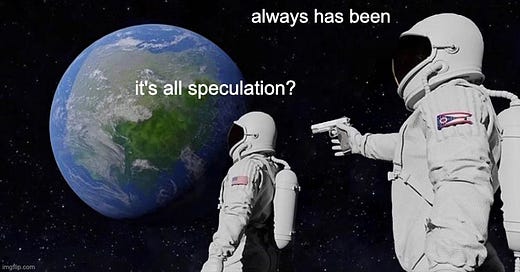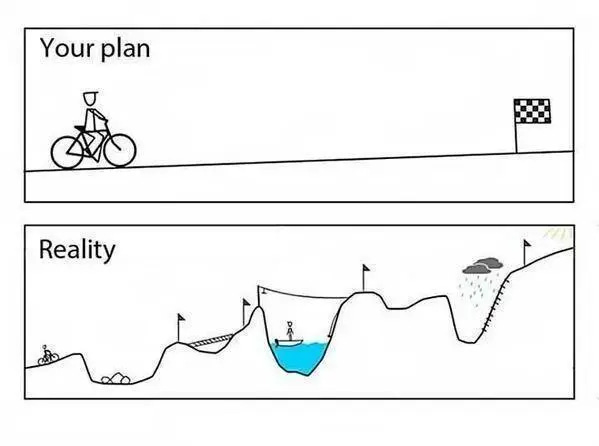Speculation: The Light Bulb Moment
Speculation has sat shotgun during humanity’s biggest technological advancements. It is a feature, not a bug, in our industry.
With all of the noise and excitement around the memecoin casino and the Infinite Game, it’s easy to write off crypto as purely speculative. Many have cited this most recent bull run as overt hyper-gambling, financial nihilism, and vaporware. While speculation certainly drives a large amount of activity, it would be reductive to classify this as a net negative in our industry. Speculation and gambling might be in the same family, but they’re far from twins.
Casinos themselves feel far from real. There are no clocks, and time seems to slow to a crawl. The floor is designed like a maze, making it difficult to navigate or leave. You’re quite literally restricted from the real world, and distracted as jackpots are hit and major winners scream and shout (which is, admittedly, a lot more fun than posting a Phantom wallet screenshot). Enjoy it, but do not let the fanfare of the casino distract you from the potential of our industry.
I grew up in Las Vegas, and I’m no stranger to high-risk games. I’ve seen my hometown grow exponentially on the backs of gamblers, and we literally don’t pay a state income tax because the casinos shoulder it all. I’ve seen Vegas become the fastest growing city in America, attract all types of companies like Zappos and Gusto, and become something much bigger than the Sin City moniker. I have even loftier goals for our industry.
Everything is speculative
Speculation is not just the domain of high-stakes investors or futurists; the fabric of modern society is woven with threads of speculation.
The philosopher Søren Kierkegaard once observed, "Life can only be understood backwards; but it must be lived forwards." From the moment we wake up, we're engaged in a constant process of anticipating and preparing for future events. Our morning commute is based on speculation about traffic conditions and arrival times. Our choice of clothing often reflects speculation about the day's weather or social interactions.
In the workplace, projects are planned and resources are allocated based on speculative projections of market trends and consumer behavior. Even our social lives are influenced by speculation, as every swipe left or right on a dating app is filled with what can be. This continuous process of forecasting and adapting to potential futures is so ingrained in our daily lives that we often overlook its pervasive influence.
We're perpetually engaged in a dance with uncertainty, using our capacity for speculation to navigate the complexities of modern life and shape our reality. What’s more, behind uncertainty lie some of the greatest opportunities.
Speculation 🤝 Innovation
Throughout history, speculation has sat shotgun during humanity’s biggest technological advancements. Technological progress is accompanied by visionaries who dedicate themselves to concepts that may seem impractical or far-fetched in the moment and require advance capital and tremendous foresight to develop. In the 15th century, for example, the printing press was not an overnight success; it was preceded by decades of speculation about the transformative power of movable type and the democratization of knowledge. Similarly, the development of steam power in the 18th century was made possible by earlier speculative investments in coal mining, metallurgy, and engine design. None of these were straight lines.
Time and again, the most impactful innovations have been the result of courageous individuals and organizations willing to bet on the future, often long before the fruits of their labor come to fruition or after numerous failures. In the realm of pharmaceutical development, the story of penicillin illustrates how even accidental failures can lead to revolutionary breakthroughs. Alexander Fleming's discovery came about when he noticed that mold contamination in one of his petri dishes had killed the surrounding bacteria - a "failure" in his original experiment that led to one of the most important medical discoveries of the 20th century. It would be foolish to point to any number of failures without acknowledging the role they’ve played in our greatest successes.
Take the .com boom for example, a period in which $1.7 trillion in value was lost from March 2000 to October 2002. One could simply cherry-pick Pets.com or any number of instances from the speculative mania that ensued, but doing so would be missing the point. The .com bubble laid the groundwork for the modern digital economy, e-commerce, and social media platforms we now take for granted (and took decades to build). Value lost during that time period is but a blip when you zoom out.
Speculation in crypto is good
Given that speculation is foundational to the human experience and there are clear examples as recent as the past decade in which rampant speculation have fueled innovation and growth, it would be silly to reduce the entire crypto industry to senseless hyper-gambling. No one cares about Thomas Edison’s 1,000 failures or any of the ultimately unproductive paths it took him down; there are now 8 billion light bulbs in the world.
Hyperfixation on present failures misses the forest for the trees. The success case for crypto is already underway, as Bitcoin eclipses $1.2T in value and the rest of crypto adds another trillion. Given gold is a $15T asset, it’s easy to zoom out and see the blue ocean of opportunity still sits before us, and any failures or missteps look quite small in comparison. In fact, the entirety of crypto outside of Bitcoin could go to 0, and we still have a massive venture-scale opportunity on our hands (and hint: we aren’t going to 0). Bitcoin has already broken into the lexicon of the common man, and will remain the industry’s north star for the foreseeable future given its simplicity, immutability, and ubiquity.
Things must be tried, money must be burned, and people must fail in order to get to the light bulb moment. The good news is, we’re trending in the right direction as Bitcoin becomes more globally adopted and demand continues to increase over time (in spite of many’s best efforts to kill the industry).
You might be thinking to yourself, “Okay Sterling, but how does buying Smoking Chicken Fish contribute to the overall value prop of crypto?” or “Hey Sterling, isn’t Solana only memecoins? How is it so valuable?” or “Sterling, my wife told me that the youthful exuberance she fell in love with died years ago, can you help me?”
First, part of crypto’s allure is and always will be tied to the Infinite Game, and that will likely never change in an internet-first, synchronous community. These speculative games have always drawn the most attention, and Bitcoin’s primary attractiveness has always centered around its ability to redistribute wealth to anyone willing to believe in its long-term value proposition. It’s a feature, not a bug.
This speculative behavior extends to every crypto cycle. Last cycle, we saw NFTs take the world by storm as people explored all of the different ways verifiable behavior and ownership could be valuable. The bottleneck to innovation ended up being infrastructure, as gas fees priced many early adopters out and the sandpaper-level friction in onboarding made my parents cry real tears. The unworkable infrastructure ended up dealing a massive blow to the industry, as nascent business models incentivized rugpulls and few developers could execute on the grand visions NFTs offered. There were scams, sure, but there were many earnest attempts to leverage the technology, and the story of verifiable fanhood is far from over.
I hope it’s over for these guys, though
Memecoins are not only a better form factor for speculation given wider distributions, cheaper prices, and more digestible value propositions, but they’ve also tested crypto’s infrastructure improvements over the past several years and the systems have all run fairly smoothly.
When considering that many institutions’ biggest hesitations with engaging with the technology is its unreliability or lack of lindy properties, the seamless activity that we’re seeing in a lot of ecosystems is a necessary step in understanding just how strong our pipes have become. Similarly, early users who aren’t afraid to ape $15k onchain and lose it in a myriad of ways are extremely valuable pioneers as we develop solutions for the common man.
The advent of stablecoins has had a profound impact on DeFi, but it has also had its own Penicillin moment, where people in emerging markets have been able to access dollar-denominated savings accounts, avoid predatory fees on cross-border payments and remittances, and access global markets. The global remittance market sits at $740B; these are goliath opportunities with a clear path to victory.
For Yellow Card – the most popular exchange in Africa doing hundreds of millions in monthly volume – their users aren’t buying memecoins, but instead primarily trading the Naira and Dinar for the much more stable USDC or USDT. This behavior extends to Southeast Asia and Latin America, where inflation and hyperinflation plague the regions and traditional US dollar access is restricted.
Payments offer a similar respite from the financial systems that serve to choke out small businesses. Companies like Blackbird have largely abstracted the “crypto” part of the business away, and restaurants around the world have opted to use them because they help save on transaction costs and lower CAC for reward-seeking diners. TYB, on the other hand, provides a refreshed look at loyalty, and the opportunity to reward consumers for their engagement beyond the dollars they spend. These companies are seeing meaningful upticks in conversion, spend, and retention compared to their traditional counterparts, and for the first time, we’re starting to see real adoption of crypto rails that sit beyond the typical “crypto” user. Networks, when successful, become extremely valuable, and winners who experiment in these verticals will see massive success.
Prediction markets have leveraged speculative behavior to better incentivize truth in polling, and companies like Polymarket have started to see mainstream success with nearly $500m in volume this month alone. Drift also recently added prediction markets on Solana, and we’ll soon see embedded Blinks anywhere people argue on the internet.
The road to tokenizing will be paved with categories that might seem silly at first glance when you realize that everything could very well mean everything, from carbon credits to ETFs to whiskey to recipes to cattle. That said, we are already making major steps towards this mission as Securitize launched BUIDL in a partnership with Blackrock to bring their first tokenized fund to market. Even BCAP’s early fund was tokenized because things must be tried and the game must be played (sorry, but I refuse to use the term “arena”).
Beyond the casino
A generally chronically online user base is prone to highly emotional mood swings, and sensationalist media outlets are just waiting for the next opportunity to call out the insanity of our industry, so I don’t blame people for becoming discouraged or nihilistic when looking at recent activity. The very nature of crypto is subversive to existing financial systems; you’re supposed to feel like the world around you is breaking and absurdism is usually a close companion. The good news is that you also get to play a major role in the solution. Plenty of ideas are being tried, and many of them are destined to fail. So it goes.
The crypto casino might seem like a fever dream of pixelated punks and dog-themed tokens, but beneath the meme-fueled madness lies the potential for real, transformative change. So whether you're here for the tech, the gains, or because your wife’s boyfriend told you Bitcoin was going to 100k, all we need is a light bulb moment.









Even tho it sucks seeing market manipulation and destruction of regular people's capital, I hope that the real use cases shine through. I think of this for car loans - could be very easy to use the world computer to enable ease of use around lending via onchain credit/even encrypted onchain credentials.